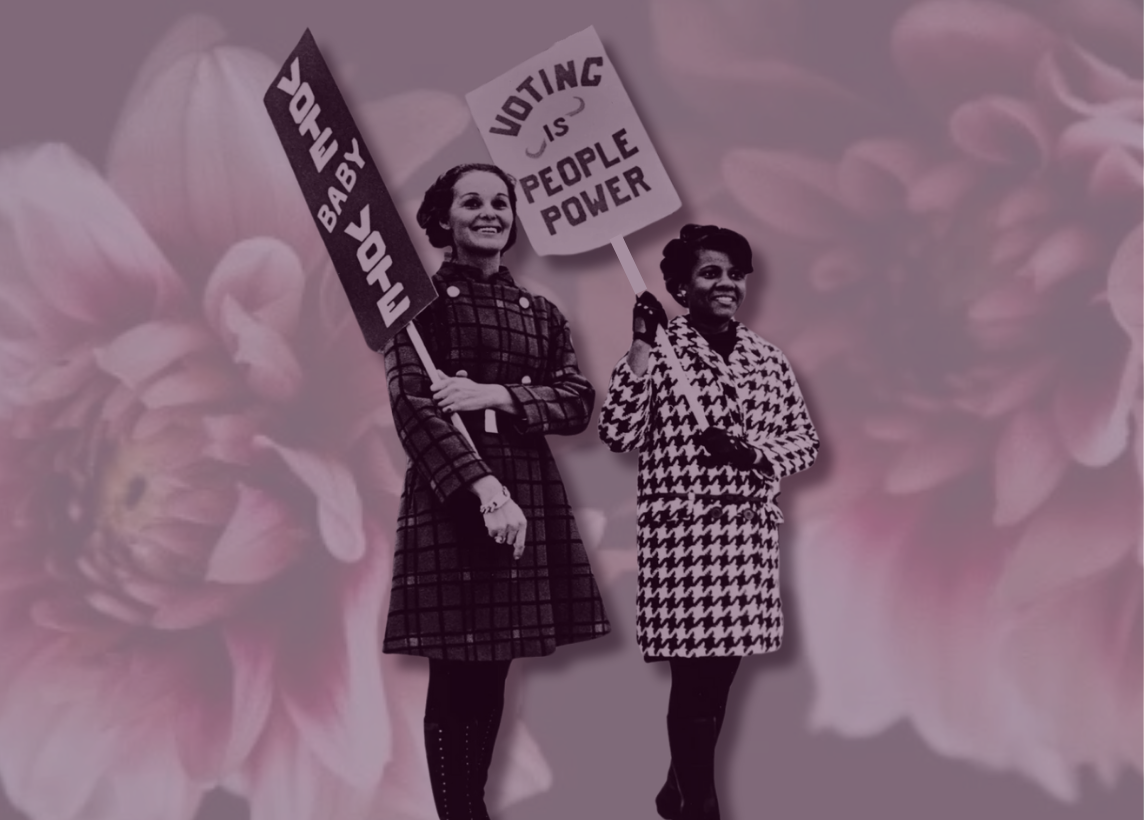
“If the first woman God ever made was strong enough to turn the world upside down all alone, these women together ought to be able to turn it back, and get it right side up again!”
– Sojourner Truth
In 1848, the first women’s rights convention was held in Seneca Falls, New York. Three hundred people were in attendance – not to rally in support of a political party, but to agree and take action on the radical notion that voting is a fundamental right for every citizen.
Two years later, the first official National Women’s Rights Convention was held in Worcester, Massachusetts, and attracted 1,000 attendees. Sojourner Truth delivered her now famous speech Ain’t I A Woman? at a women’s rights convention in Akron, Ohio in 1850.
After equal rights rested on the back burner during the Civil War, Elizabeth Cady Stanton and Susan B. Anthony formed the American Equal Rights Association in 1865 and petitioned Congress for “universal suffrage” to ensure voting rights for everyone, including African Americans. In 1868, Black men were granted the right to vote.
The very same year, suffragists split into two organizations: The National Woman Suffrage Association that maintained focus on amending the Constitution, and the American Woman Suffrage Association that aimed toward voting rights for women in each individual state.
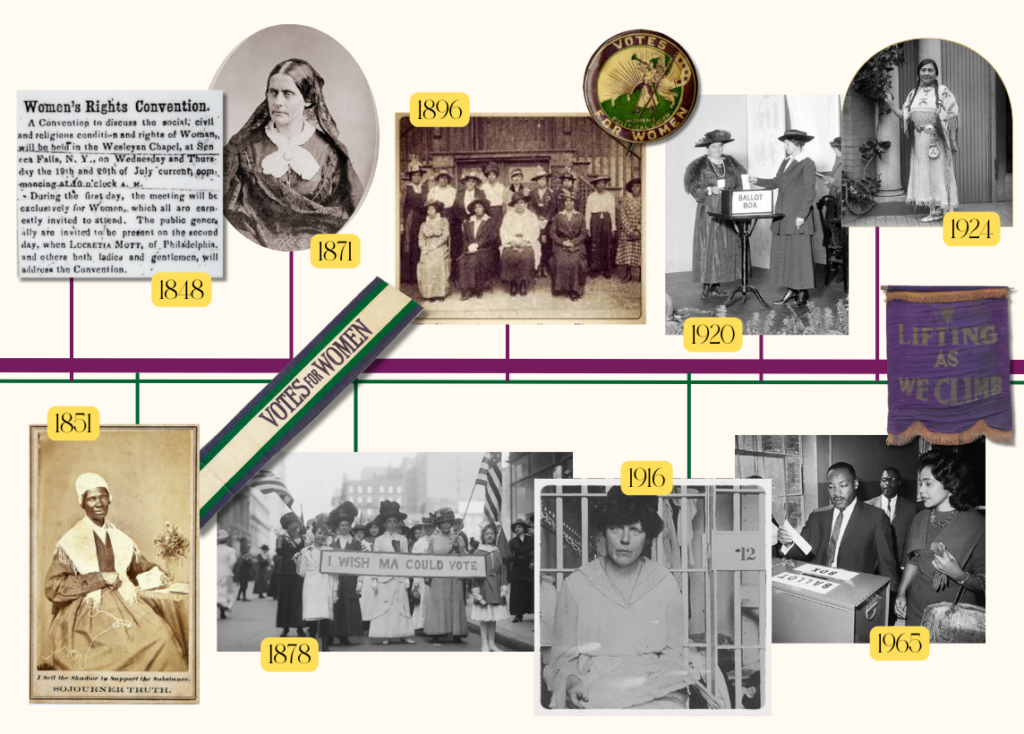
In 1870, Victoria Woodhall addressed the House of Representatives with an argument that women do indeed have the right to vote under the 14th Amendment. Her argument was ultimately shot down, yet she continued to stand, even as the Anti-Suffrage Party formed the same year. Victoria is largely considered to be the first woman to have run for president in 1872, though even if elected, she would have been considered too young to hold the position.
“They cannot roll back the rising tide of reform,” she often said. “The world moves.”
As women continued to inspire and uplift each other across the country, Susan B. Anthony registered and voted for Ulysses S. Grant in 1871. She was arrested and tried for voting illegally, though her conviction didn’t come until 1873.
Our beloved suffragettes will always be remembered for never backing down. Many years and protests later, women finally won the right to vote in 1920.
(If you’re still curious about the history, click here for a complete timeline of Women’s Suffrage in the United States.)
As voters, we exercise our fundamental rights. As women, we continue to carry the weight of fighting for our fundamental rights and know that it has always been an uphill battle.
Still, we persist.
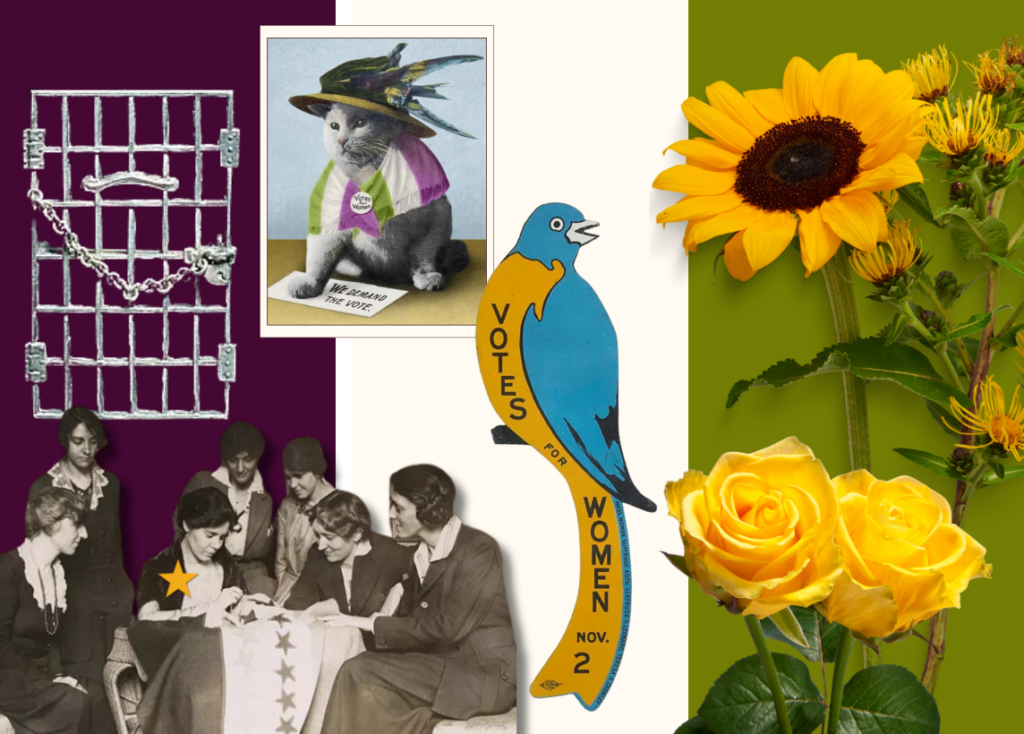
The fight for equal rights and freedoms continues as we keep the legacies of Suffragettes alive and honored. They would be proud to see how far we have come and how diligently we continue to push forward.
The overwhelm of social media in the present day has been soothed by instant and real-time updates straight from activists themselves. Where traditional media may (and often does) miss the mark, we now have incredible access to the world and government in a way the Suffragettes would both envy and celebrate.
With the world almost literally at our fingertips, organizing to take a stand in our everyday lives has become as vital as holding our elected officials accountable. The power of the people formed from community, and coming together as citizens is a crucial step toward societal shift.
Suffragettes and the opposition alike utilized symbols to spread their messages. The Women’s Suffrage Bluebird sign was present in the tens of thousands in 1915 to support a Massachusetts state referendum to grant women the right to vote. Cats were also used to represent women as delicate, demure, apathetic, and ultimately undeserving of the same freedoms as their male counterparts. Similarly, cats were also used to represent a loss of masculinity as the country worried that men would be expected to tend to the house and raise children should their wives gain the freedom to be a functioning member of society.
Thankfully, cats have long since been reclaimed as a feminine symbol of independence and power.
Colors also played a big role in recognizing the equal rights movement. The National Women’s party utilized purple, white, and gold in their flag.
The organization described the meaning of these colors in a newsletter published December 6, 1913: “Purple is the color of loyalty, constancy to purpose, unswerving steadfastness to a cause. White, the emblem of purity, symbolizes the quality of our purpose; and gold, the color of light and life, is as the torch that guides our purpose, pure and unswerving.” (source)
Suffragists in Kansas embraced their state flower, the sunflower, as a symbol for their cause. Roses were also a prominent symbol for suffragists and anti-suffragists alike. When it came down to lobbying at the Tennessee State legislature in 1920 to ratify the 19th amendment, rose-shaped pins were a clear sign of which side one would take: white roses for voting rights, red roses against.
As progress slowly and steadily gained traction over the decades, our affinity for symbolism has evolved into a passion for keeping our stories and efforts on the front lines. Now more than ever, we are capable of being the change we wish to see in the world, and we have an entire history of inspiration to propel us forward. We recommend Sharon McMahon’s book The Small and the Mighty, Shaina Taub’s book (and musical!) Suffs, and the stories below if you’re looking for a place to start.
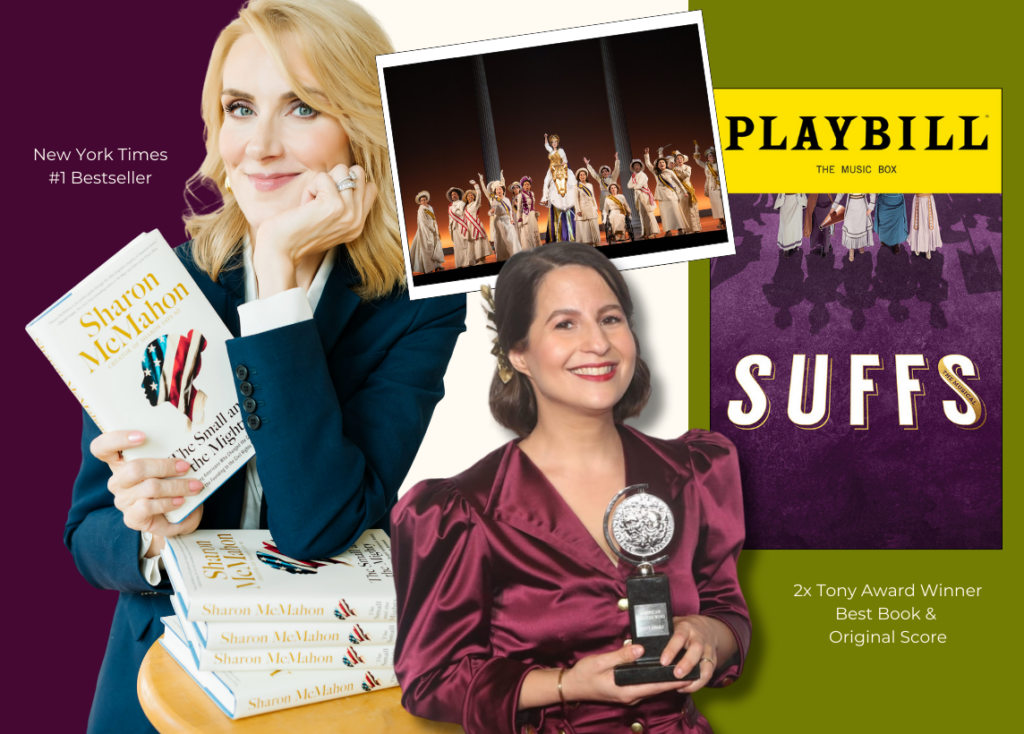
“It was we, the people; not we, the white male citizens; nor yet we, the male citizens; but we, the whole people, who formed the Union. And we formed it, not to give the blessings of liberty, but to secure them; not to the half of ourselves and the half of our posterity, but to the whole people – women as well as men. And it is a downright mockery to talk to women of their enjoyment of the blessings of liberty while they are denied the use of the only means of securing them provided by this democratic-republican government – the ballot.”
– Susan B. Anthony, 1873 (source)
Susan B. Anthony spent her activist years focused on the abolition of slavery before she was arrested for illegally voting as a citizen of the United States. Her strong belief in equality was a driving force throughout her life. Now, her grave is adorned with I Voted! stickers from women who made their voices heard in just about every presidential election.
Every single woman involved in the voting rights movement is an icon to those who continue their legacy. Our journeys are indeed nonlinear and often uphill, so we draw strength in coming together to support each other along the way.
One shining example of a true girl’s girl is Inez Milholland. Born to a wealthy family in New York, Inez met Emmaline Pankhurst in England and came back home burning with inspiration from the militant suffragist. Armed with a vivacious spirit of defiance and her family’s wealth, Inez helped to organize fundraisers, pay bail for protesters, and was even arrested herself for picketing alongside factory workers. After finally finding a law school that accepted women and earning her degree, she donned a white dress and led the famous Suffrage Procession in Washington D.C. on horseback in 1913.
It often comes as a surprise when we hear stories about women who lived so long ago and dealt with the same injustices we still face today. The emotional labor alone of explaining why humans deserve equal rights sometimes feels like screaming into the void. This is why it’s important to share our stories, especially those of women that have been silenced or swept under the rug.
When that happens and I’m left discouraged, I think about Alice Paul. She was born in a Quaker community where equality of the sexes was simply never a question, and she often accompanied her mother to suffragette gatherings. Alice pursued both education and a career in social work that took her all the way across the pond from New York. Her time in England and her mother’s influence inspired her passion to fight for equality in her home country. She was one of 1,000 Silent Sentinels that protested in front of the White House for voting rights in January of 1917. During the eighteen month protest, they stood silent and still yet endured physical and verbal attacks from citizens. Alice was one of many eventually arrested on the charge of obstructing traffic. She organized a hunger strike during her seven months in jail, attracting support from the media as well as President Woodrow Wilson, increasing the momentum along the home stretch toward the long-awaited amendment.
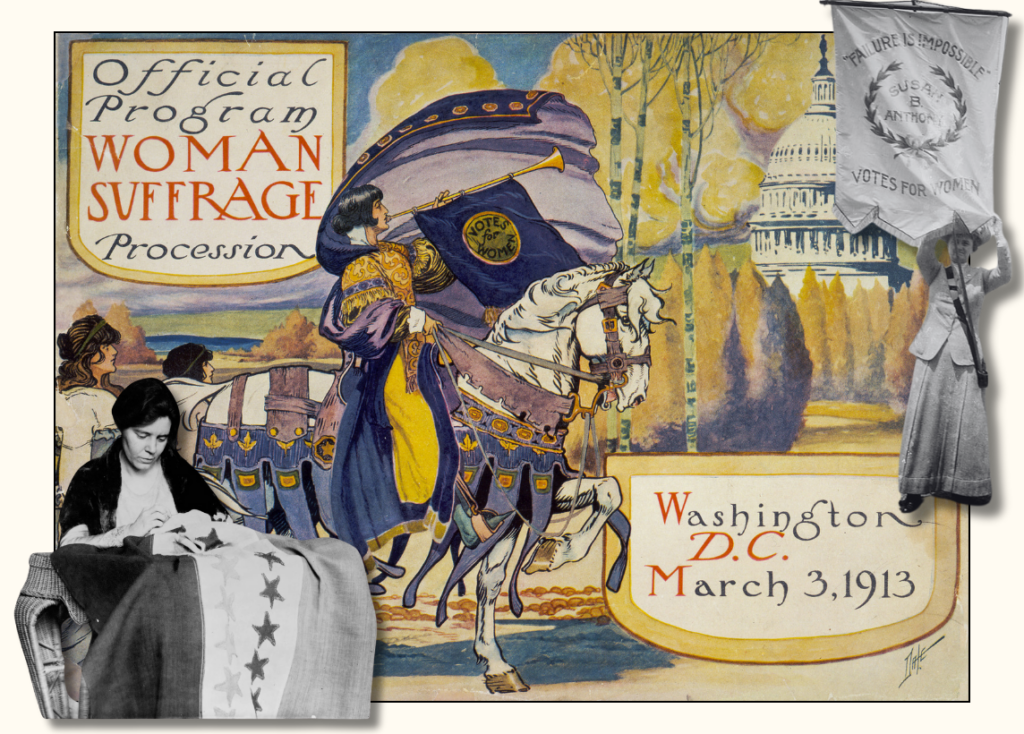
With all of this in mind, the question still weighs heavily on American women as November inches along in the wake of the election results: what do we do now?
We continue to speak. Our voices will echo through the centuries as a testament to our resilience and belief in equality, just like Susan B. Anthony.
We continue to fight. The reason we began in the first place is because the suggestion of equal treatment for human beings was met with resistance. Just like Inez Milholland, we simply will not settle for less.
We continue to push forward – for our rights and those of others. No one is free until everyone is free. Alice Paul knew it a hundred years ago, and we still know it today.
We also grieve. We rest when we are tired and find endless ways to pick back up again. We are the daughters of the resistance and the matriarchs of a new era of equality.
Sources:
https://www.nps.gov/articles/sojourner-truth.htm
https://www.theattic.space/home-page-blogs/woodhull
https://www.nps.gov/articles/symbols-of-the-women-s-suffrage-movement.htm
https://www.womenshistory.org/education-resources/biographies/susan-b-anthony
https://www.nps.gov/people/inez-milholland.htm
https://www.womenshistory.org/education-resources/biographies/alice-paul
+ view the comments



Thanks for sharing this glimpse of women in history, and reminding us that we are still a part of that non-linear journey.